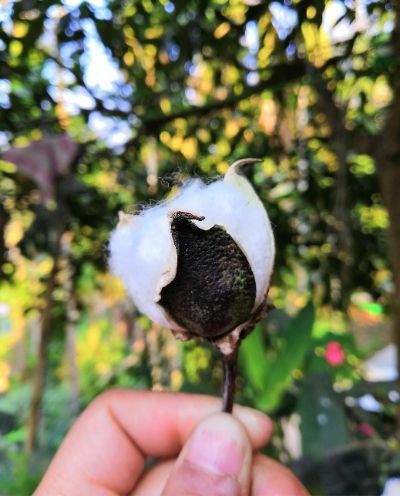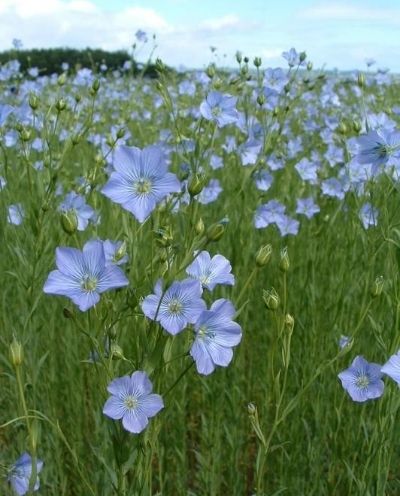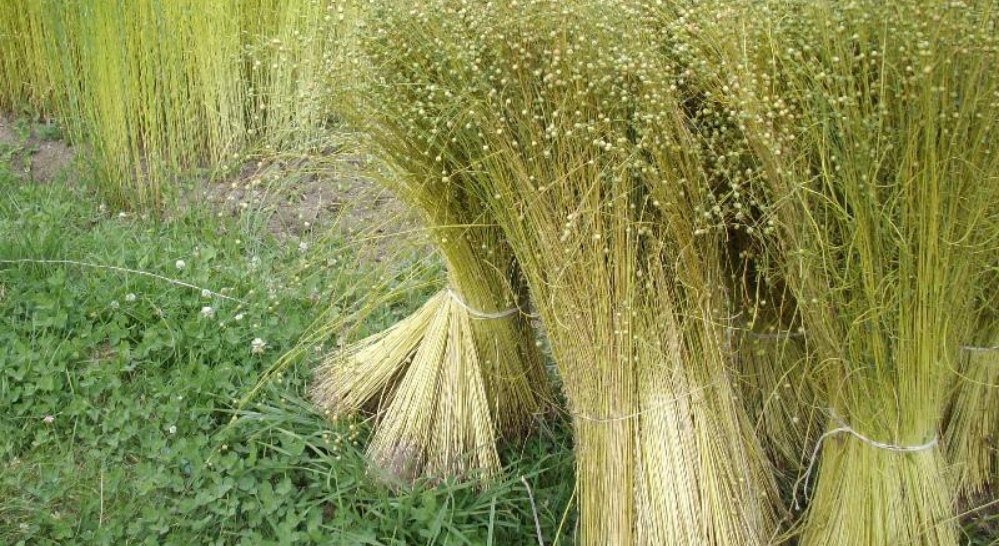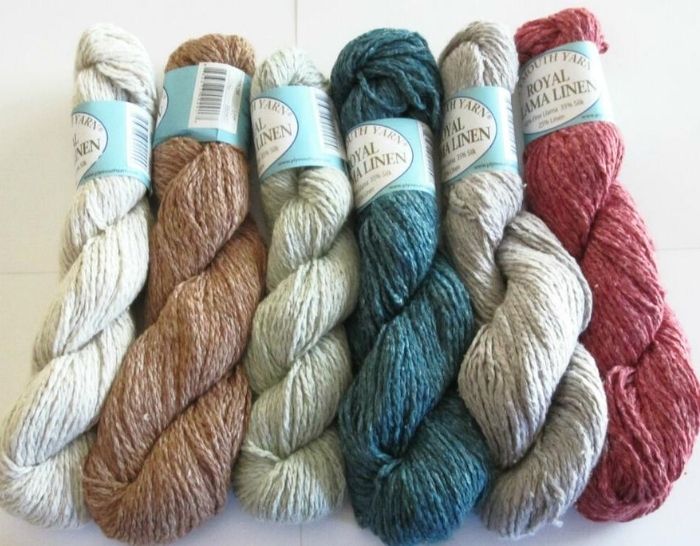Eri Silk: An Eco-friendly Fiber – Other Eco-Friendly Fibers?
As people in close touch with the Eri Silkworm rearers and weavers, we at Muezart, know Eri silk fiber to be an eco-friendly fiber. Why?
No toxic chemicals are used in its production. The only ‘chemical’ that comes in touch with it is alkaline soap that is used during the degumming process. And the whole cycle, from silkworm stage to fiber, is very eco-friendly and sustainable too. How do we say that?
- The Eri silkworms are fed castor or tapioca (cassava) leaves – both regenerates quickly and they grow organically.
- After that is the cocoon production stage, where the cocoons are degummed by boiling them in water with a locally procured alkaline soap. The soap we use is handmade by the villagers.
- Then is the dyeing stage. At Muezart we use natural ingredients. Even for mordant (the thing that helps the color to stick to the fiber) our Eri silk dyers use plants. For some colors, like when dyeing with mulberry fruits and onion skin, Alum works better as a mordant. So, to experiment, we tried Alum as mordant – that too very little of it – just 2 tablespoons for a large vat. On checking up we find that Alum, which is Aluminium Sulfate is non-toxic – unless ingested or inhaled – both of which are not a cause of worry for Muezart. In fact we see that lakes are being cleared of algae using Alum.
This got us thinking. Which other natural fibers are eco-friendly fibers?
We look at three plant-based fibers – cotton, hemp and linen; and two fibers produced by moths – Mulberry silk, and Eri silk. Let us see what it takes to produce these fibers and fabric from them and check if any of them are eco-friendly fibers too.
1. Eri Silk from Meghalaya – Steps from Eggs to Fiber:
- Eggs hatch to become Eri silkworms.
- Worms are fed castor or cassava leaves. No fertilizers or pesticides are used as castor leaves grow abundantly in Meghalaya and are not infested.
- Cocoons form: Once fully grown, each silkworm spins itself a cocoon and goes into hibernation to transform itself into a moth.
-
Degumming of the cocoons: The moths leave the cocoon and the cocoon is degummed by boiling in water with an alkaline washing soap. This is the only stage where a ‘chemical’ – which is an alkaline soap – is used. Alkaline soap is eco-friendly unlike detergents.
-
Yarn is made: The Eri silk fiber is hand spun from the cocoons and then made into Eri silk yarn for weaving or knitting.
- The yarn is woven into fabric either before dyeing or after.
- Dyeing is done using natural dyes. No toxic chemicals are used.
*Alkaline Soaps are made from plant oils like coconut oil etc or acids derived from animal fat. Detergents, on the other hand, are synthetic, man-made derivatives.
So, note that no toxic chemicals are used in any stage of the Eri silk production process. We speak with confidence about the Eri silk that Muezart produces. We can vouch that it is a eco-friendly fiber and the production cycle is sustainable.
2. How Eco-Friendly is Cotton?

Cotton is from a plant. It is a fiber we cannot live without. Its fiber structure can absorb nearly 3 times its weight in water. On top of this, cotton breathes, and so body sweat is absorbed and moved away from the skin.
Unfortunately, though, both its cultivation and processing cause environmental damage as lots of toxic chemicals are used. This crop is intensively sprayed – we understand that 10% of pesticides used, and over 20% of the insecticides used on crops all over the world, are for cotton fields.

But, there is the option of organic cotton. So, let us look at that. Is organic cotton an eco-friendly fiber?
Organic Cotton is produced without the use of genetically modified seeds, pesticides, insecticides or other chemicals that could harm the environment.
Cotton – The Steps from Seeds to Yarn
-
Seeds are planted and cultivated. The seeds used are quite often the genetically modified variety. The seeds germinate in 15 days. The fields need frequent weeding and pest management. Hence, during this phase weedicide and pesticides are used. These are toxic chemicals like deltamethrin and endo-sulfan, parathion, methamidophos, and alpha-cypermethrin.
For organic cotton non-GMO seeds are used. During cultivation nature given chemicals like sulfur dust and other pest control agents like organic acid-based sprays, such as citric acid sprays are used. To control pests, organic farmers may use beneficial predator insects, crop rotations, intercropping, and biological pesticides such as neem oil. -
Harvesting: During harvesting, herbicides are used to defoliate cotton plants (to help the leaves to fall), to make picking easier.
Organic cotton growers pick by hand. You can imagine the increase in labor cost, which pushes up the price. - Cleaning or "ginning" – no chemicals are used.
- Steps – from cotton fiber to yarn to fabric.
- Spinning the cotton fibers to create yarn – in this stage no chemicals are used.
- Weaving or knitting to make fabric. This process needs help with chemicals to make them shrink proof etc. Organic cotton fabrics are not treated.
- Dyeing and printing – here too chemicals are used and the wastewater ends up being toxic for the environment. Organic cotton fabrics are processed without chemicals.
- Finishing process to create a smooth fabric, to make it shrink proof etc. needs chemical treatment.
So, organic cotton needs a lot more labor and investment. It needs some amount of nature given weed and pest controlling additives too.
3. What is Hemp?
This too is a fiber from a plant. Unlike cotton which comes from the flower, hemp fiber is the cellulose fiber from the stalk of a plant. The plant grows tall – around 3 feet – and the strands from its stalk is hemp fiber.
It is an eco friendly fiber and is sustainable. The plant does not need much water and is pest resistant. Hemp fiber is a little like linen and can be used for clothing, home furnishing and for carpets.
In the early 1900s most of the clothing in England were made with Hemp. It was widely used for paper and textile. There was some controversy as hemp looks like the marijuana plant. Though they belong to the same genus, hemp has no more than 0.3% by weight of a psychoactive substance.

Hemp – From Steps form Seed to Fiber:
- Seed planting and cultivation: Seeds, organically collected from the plant, are used. So, no GMO seeds. Weeding is needed and some farmers do use weedicides. Some use Nitrogen based fertilizers, which can be organic, to stimulate growth. It is ready for harvest in 3 months.
- Harvesting: These plants grow thin and tall. They are best harvested before seeds form (Note: some farmers grow hemp plants only to harvest their seed). The stalks are cut close to the base and the harvest is left to rot in the field for close to 5 weeks. This process is called ‘retting’(not ‘rotting’).
- The fiber is removed by passing the dried stalks through a machine. This process too is chemical free.
- These fibers are then spun together to produce a continuous thread that can be woven into a fabric.
So, from what we learnt, Hemp can be grown organically with ease. It is slowly gaining back its popularity, both as a fabric and as a fiber that can be mixed with cotton and silk.

Hemp Farming 101: A Beginners Guide for Growing Hemp
4. What is Linen?
Linen fiber is also a cellulose fiber, like hemp, from the stalk of the flax plant. Globally the demand for linen fabric is on the rise.
You may have heard about Linen fabric, flax seed and linseed oil – but did you know that these are the products of the same plant?
Flax seed is the seed, very rich in omega-3 fatty acids and a favorite of health watchers.
Linseed oil, which is the oil of flax seed, has many uses, one of it is as an additive to help oil paint dry. Now-a-days even for that chemicals are used. But if you know someone who does oil painting you will notice they add linseed oi to their paint, before applying the color to their canvas.
Linen is the fiber that we get from the tall stalks of the flax plant and it can be made into yarn and woven into fabric.
The plant grows best in cool climates.

Linen – Steps from Seed to Fabric
- Land is prepared, flax seeds are planted and cultivated. This plant needs very little water but chemical fertilizers, weedicide are used.
- Harvest: The plant grows to 3 ft in height and is ready for harvest when the flowers appear. Those who grow flax for seeds harvest the seeds after 4 months, while those who grow flax plant for linen fiber harvest after 3 months. If the plant is cut after 4 months the quality of the fiber goes down.
-
Left to dry: The harvested long stalks are left on the field to rot – till the inner fiber is ready to be removed – then they are dried.

- Fiber separated: The stalks pass through a machine to separate the fiber.
- Long and short fiber got: The output is then combed with metal-lined combs to get smooth, long, straight, flax fiber called line flax, and tangled fluffy fiber called tow. Line fax is used to make high quality fabric (a bit shiny) and tows are used to make fabric for everyday goods.

Fiber Flax Planting and Processing Instructions
Grow Flax For Linen In Your Garden
5. Mulberry Silk – How Eco-friendly?
Mulberry silk fiber is from the cocoon of a moth called Bombyx Mori. 80% of the silk in use globally is Mulberry silk.

Mulberry Silk – Steps from Silkworms to Silk Fiber:
- Eggs hatch into silkworms.
- Worms are fed mulberry leaves – the cultivation of mulberry leaves requires chemical fertilizers, herbicides and pesticides. We found out that an annual input of 1.40 mt. of chemical fertilizers are applied in one acre of mulberry plantation.
- Cocoons form: Once fully grown, the silkworm spins itself a cocoon and goes into hibernation.
- Cocoons are harvested: The cocoons are boiled in water to kill the moths inside so that they do not emerge and cut the cocoon shell. When the cocoon is intact, one can get a single, long fiber.
- The cocoon is degummed by boiling in water with an alkaline washing soap
- Bleaching process: The mulberry silk fiber goes through a bleaching process which uses toxic chemicals like sulfur dioxide, hydrogen peroxide etc.
- At times mulberry silk fiber undergoes a process for optical whitening too – to make the fabric whiter and bright.
- The fiber is spun and then made into yarn for creating fabric by weaving or knitting.
- For dyeing and printing too chemical dyes are used.
So, as Mulberry silk industry is highly commercialized it is not easy to get eco-friendly mulberry silk fabric. You may find this post that compares different types of silk interesting.

Which of These Fibers Have You Tried?
The exercise of researching about other potential organic, eco-friendly fibers was an engaging one. We have shared with you what we gathered. Looking at it, we do have good options in hemp and linen as eco-friendly fibers.
One thing we are feeling good about is that we are promoting the production of a very sustainable, eco-friendly fiber, the Eri silk fiber and in so doing, regenerating a cottage industry of our state, Meghalaya.
Have you tried Eri silk fiber, yarn or fabric? What about Hemp? Do share your story with us.



Leave a comment